|
|
|
|
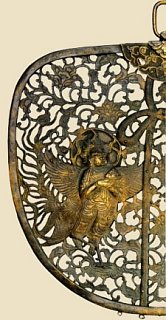  TENNIN 天人 (Skt. = Apsara) TENNIN 天人 (Skt. = Apsara)
HITEN 飛天 (Flying Apsara)
TENNYO 天女 (Celestial Maidens)
KARYŌBINGA 迦陵頻伽 (Bird Body, Angel Head)

Literally = Celestial Beings
Angelic Attendants, Celestial Maidens, Divine Fairies,
Flying Apsaras, Flying Celestial Maidens, Heavenly Beings
& Goddesses, Heavenly Musicians (Gakuten), Heavenly
Nymphs, Karura (Skt. Kalavinka), Karyōbinga,
Kendatsuba, Kinnara, Other Musical Attendants,
Tennyo (Enmusubi, Futokku, Kudoku)
Also see Dunhuang Caves in China
The heavenly beings presented here are not objects of worship. Rather, their function is to protect Buddhist law by serving the Deva (see TENBU). Most originated in India’s earlier Vedic traditions. The Sanskrit term for these celestial beings is Apsaras (also Apsara) -- it refers to the divine beauties and dancers who populated Lord Indra’s court in Hindu mythology. In Japan, the term Apsaras is rendered as TENNIN (heavenly beings), a group that also includes the TENNYO (celestial maidens). In artwork, they appear most frequently as dancers and musicians who adorn Buddhist statuary, paintings, and temple structures in China, Japan and Southeast Asia. Their attributes are not clearly specified in Buddhist texts, and thus their appearance is quite varied. In Japan, they are often shown standing or sitting on clouds or flying through the air in graceful poses, playing musical instruments, or scattering flowers to give praise to the gods. A similar but separate class of heavenly attendants is the KARYŌBINGA. They appear in Japanese art with the head of a BOSATSU (Bodhisattva) and the body and wings of a bird.
Devakanya. Sanskrit term for goddesses in general; refers to female divinities; in Japan equated with the term Tennyo 天女. Other Sanskrit terms include Apsaras, devi, sura-kanya, deva-kanya, dev apsaras, bhagini, maru-kanyaka, marut-snusa, sura-bandhu, and sura-vadhu. Tibetan = lha’i bu mo). <Source: Digital Dictionary of Buddhism by Charles Muller; sign in with user name “guest”>

 |
|
  TENNIN 天人 (Skt. = Apsaras, Apsara) TENNIN 天人 (Skt. = Apsaras, Apsara)
Literally “Heavenly People” or “Celestial Beings.” Originated in earlier Vedic mythology. This group includes the Flying Apsara (Hiten 飛天), the Celestial Maidens (Tennyo 天女), and the Bosatsu on Clouds (Unchuu Kuyou Bosatsu 雲中供養菩薩). Famous effigies of the latter, from the 11th century, can be found at Byōdōin Temple 平等院 in Kyoto’s Uji district. Says the Buddhism Flammarion Iconographic Guide by Louis Frederic:
“The Apsaras are celestial beings, which are not in fact deities subject to worship, but merely the servants of the Deva (Jp. = Ten). Mostly they are dancers and musicians, and were widely used for the decoration of temples and sanctuaries, especially in Thailand, Burma, and Laos. They are not specially worshipped, although people do accord them some veneration by placing flowers, water, and rice at their feet. Particularly in China and Japan, they are found standing on lotuses, or seated or standing on clouds. They are then sometimes treated as Bosatsu (Bodhisattva), as in the sculpture on the walls at the Byōdōin at Uji in Japan. They usually wear light and floating celestial garments, embellished with scarves of gauze (Jp. = Tenne), and sometimes play musical instruments.” < end Flammarion quote >
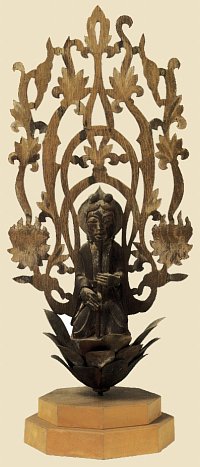 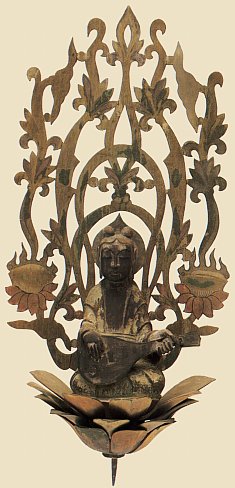
TENNIN (Apsaras) -- Celestial Beings
(L) Tennin playing a type of flute (tatebue 竪笛)
(R) Tennin playing the Japanese mandolin (biwa 琵琶)
Wood, Height = 49.2 cm, Asuka Era, 7th Century
Attached to the canopy in the Kondō Main Hall
at Hōryūji (Horyuji) Temple 法隆寺 in Nara.
Photos courtesy of 1994 Exhibition Catalog entitled
“Treasures of Hōryūji Temple,” Tokyo National Museum

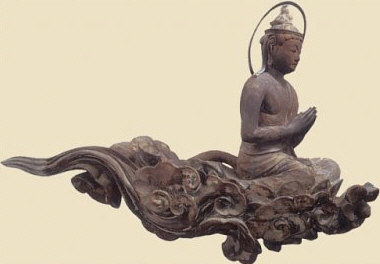
Bosatsu on Clouds, 雲中供養菩薩, 1053 AD
Also referred to as “Apsaras in Flight”
Byōdō-in Temple 平等院, North Side, #7, Height 62.4 cm
Jump to “Bosatsu on Clouds” Side Page
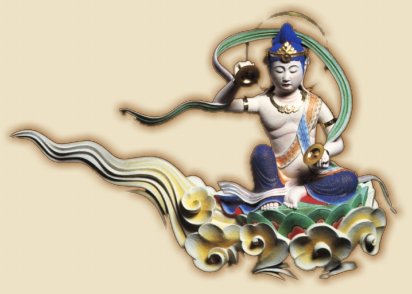
Bosatsu on Clouds 雲中供養菩薩
Modern Reconstruction, Byōdō-in Temple 平等院 in Kyoto
Photo courtesy 日本の美をめぐる, No. 45
Jump to “Bosatsu on Clouds” Side Page

Below Text Courtesy JAANUS
Japanese Architectural and Art Net Users System
Flying Apsaras = Hiten 飛天 
Literally “Flying Apsaras.” Heavenly beings invisible to the human eye, believed to fly with superhuman power and speed. Found in Middle-eastern, Indian, Chinese and Japanese art. Buddhist depictions show Apsaras flying over Buddha's pure land, praising Buddha by scattering flowers, playing instruments (gakuten 楽天), or burning incense. Important Japanese examples of Apsaras include the wall paintings in Hōryūji Kondō 法隆寺金堂, Nara (7-8c), openwork sculptures on the nimbus (Hiten-kō 飛天光) of the Byōdōin Amida 平等院阿弥陀, Kyoto (1053), and wall paintings at Hōkaiji Temple 法界寺, Kyoto (13-14c).
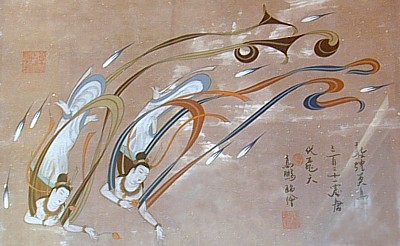
Reproduction, Flying Apsaras
Dunhuang 敦煌 Caves of China (Jp. Tonko, Tonkoo)
Please visit this side page for more details
and photos on the Apsaras of Dunhuang.
Flying Apsaras Nimbus = Hiten Kōhai 飛天光背 
Also Hitenkou 飛天光. Literally "flying Apsaras nimbus." A halo (kōhai 光背) on a Buddhist image, decorated with heavenly beings (hiten 飛天), singing and dancing in praise of Buddha. The halo surrounds the whole image, and has a pointed peak called Funagata Kōhai 舟形光背. The Hiten Kōhai came to Japan from N. Wei Dynasty China (5-early 6c) and was used on statues from the Asuka period (late 6c). The central Shaka Nyorai 釈迦如来 (623) in Houryuuji Kondou 法隆寺金堂 was an early example, but the Hiten figures are unfortunately now lost. A famous example in openwork carving, Sukashibori 透彫, is found on the Amida Nyorai 阿弥陀如来 (1053 AD) in Byōdōin 平等院 (Kyoto).
Heavenly Musicians = Gakuten 楽天 (or Rakuten) 
Heavenly Musicians. Heavenly beings (Hiten 飛天), playing musical instruments, depicted flying around a Buddha figure. A class of Apsaras. Outstanding examples can be seen attached to the canopies (tengai 天蓋) in Hōryūji Kondō 法隆寺金堂 (probably 1233 AD), Nara, and on the walls of Byōdōin Hōōdō 平等院鳳 凰堂, Kyoto (11c). Another alternate reading is Rakuten 樂天, a group of deva musicians related to the Gandharvas (Jp. Kendatsuba).
Above three entries from JAANUS

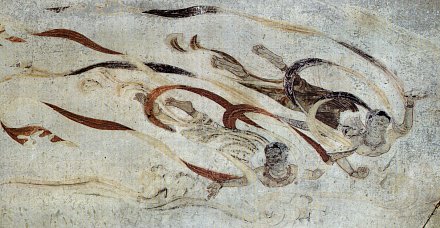
Flying Apsaras (Hiten 飛天)
Hōryūji Temple 法隆寺 in Nara, Japan
Mural, 7th to 8th Century, Approx. 136 cm wide
Photo courtesy 日本の美をめぐる, No. 11
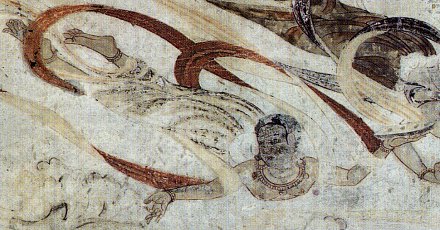
CLOSEUP OF PRIOR PHOTO
Flying Apsaras (Hiten 飛天)
Hōryūji Temple 法隆寺 in Nara, Japan
Mural, 7th to 8th Century, Approx. 136 cm wide
Photo courtesy 日本の美をめぐる, No. 11

Celestial Musician
Called 音声菩薩
Lit. = Bosatsu of Sound
おんじょうぼさつ
Octagonal Lantern at
Tōdaiji Temple 東大寺.
Nara Era, mid 8th century.
The lantern post bears
an excerpt from a Buddhist
text extolling the merits
of lighting lanterns.
Photo courtesy of
Temple Catalog, 1996 |
|
 Apsaras (Jp. = Tennin) Apsaras (Jp. = Tennin)
Story from Pali Canon
Below story courtesy NichirensCoffeeHouse.net
The Buddha returned to the palace just before the consecration as heir apparent and wedding ceremony of his half-brother Nanda, who was the 16-year-old son of Mahaprajapati and King Shuddhodhana. The Buddha gave Nanda his begging bowl and then proceeded to return to the Nyagrodha Park with Nanda in tow. Nanda was following him with the bowl in order to return it to the Buddha, but when they arrived at the park the Buddha asked him if he wished to be received into the Sangha as a monk. Overawed by the Buddha, Nanda could not but say yes. Several years later, Nanda began to regret leaving his bride-to-be, a beautiful girl named Janapadakalyani. Her last words to him the day he had trailed after the Buddha were, “Come back soon, prince.”
Realizing that Nanda was discontent as a monk, the Buddha used his supernatural powers to take him to a jungle to see an ugly little monkey. The Buddha asked Nanda, “Who is more beautiful, the monkey or Janapadakalyani?“ Nanda naturally replied that there was no comparison between the two and that Janapadakalyani, reputed to be the most beautiful girl in the land, was by far the more desirable. The Buddha then used his supernatural powers to take Nanda to the Heaven of the 33 Gods to see the Apsaras (this page), celestial nymphs, at play. The Buddha asked Nanda what he thought of their beauty. Nanda was amazed and realized that the Apsaras made Janapadakalyani look like the ugly monkey in comparison.
The Buddha then told Nanda that if he maintained a steady practice and remained a monk his reward would be rebirth among these heavenly maidens. The maidens were in fact preparing a heavenly mansion for his future arrival. After that, Nanda dedicated himself to his practice and no longer concerned himself with returning to Janapadakalyani. The other monks, however, made fun of him because of the selfish, shallow, and lustful nature of his aspirations. Nanda was mortified and at that time the Buddha came to take Nanda on another spiritual journey. This time they traveled into the depths of hell where Nanda was shown the most hideous and terrifying demons preparing an iron cauldron in which to boil a future hell-dweller. When asked whom they were preparing for, the demons replied that they were preparing for Nanda, since that would be his destination after his time in heaven had exhausted all his merits. Frightened and ashamed, Nanda finally realized the shallow and deluded nature of his previous aspirations and finally attained enlightenment thereby becoming an arhat. Some may find this story amusing, others may find it disturbing, and some may even find that it is both. I will reserve comment on it until the rest of the Buddha’s visit to Kapilavastu has been told. < end quote from Nichirencoffeehouse, as told by Ryuei Michael McCormick >

|
 |
|
  TENNYO 天女 (てんにょ) TENNYO 天女 (てんにょ)
Celestial Maidens. A subgroup of the Tennin (see above). Another term for Apsaras, but one that refers specifically to female Apsaras -- and to goddesses in general. Tennyo appear often in temple sculpture, painting, and artwork. They come in various versions, with most playing musical instruments and painted in lovely poses on the panels of temple interiors and temple ceilings.
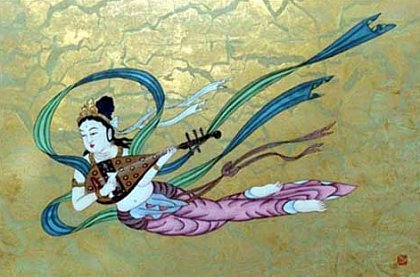
Flying Apsaras (Hiten 飛天)
Modern Painting by Artist Inaki Nobuyuki (稲木 伸行)
Also classified as a Tennyo 天女
Shown playing the BIWA (Japanese lute)
 |
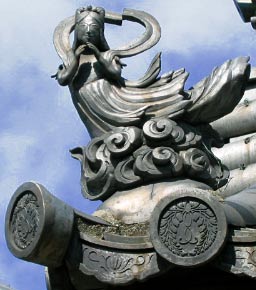
Tennyo - Temple Roof Ornament
At Hōenji Temple 法円寺 (Jōdo Sect Temple)
Ibaraki Prefecture, Photo courtesy this Japanese site
TENNYO - CELESTIAL MAIDENS
VARIOUS JAPANESE VERSIONS
- Goddesses. Includes goddesses in general, such as Benzaiten, Kariteimo, Kishijōten, and Marishiten. Some of these, like Benzaiten and Kariteimo, are worshipped independently as full-fledged divinities.
- Enmusubi Tennyo 縁結の天女
The "matchmaking" Tennyo in matters of love.
- Futokku Tennyo (or Futokko Tennyo) 福徳の天女
Goddess who brings good fortune.
- Kudoku Tennyo 功德天女 (aka Kichijouten)
Wives of the Gandharvas (heavenly musicians). Also related to the NINYO 二女, which literally means “two sisters.” One is the deva Kudoku-Tennyo 功德天女, the sister of "merit" or “achieving," who causes people to acquire wealth; the other is Kokuan-Nyo 黑闇女, the "dark" sister who causes people to spend and waste. These sisters always accompany each other. < source for Ninyo 二女 was Soothill’s Dictionary of Chinese Buddhist Terms >
- Daihi 提鞞 (Skt. Devi)
Female celestials; female deva; female Apsaras.
- Devakanya. Sanskrit term for goddesses in general; refers to female divinities; in Japan equated with the term Tennyo 天女. Other Sanskrit terms include Apsaras, devi, sura-kanya, deva-kanya, devApsaras, bhagini, maru-kanyaka, marut-snusa, sura-bandhu, and sura-vadhu.
-
 Zōonna 増女, Below text from JANNUS Zōonna 増女, Below text from JANNUS
A nou mask (noumen 能面), representing a young angel, goddess or enlightened woman. A cool reserve seen in the passive expression, flat cheeks, unsmiling lips, and intelligent high forehead lends this mask a stately dignity that contrasts with the open expression of Koomote 小面 (Ko-omote) and other standard young women's masks. The downcast eyes, narrow features, and horizontal brush strokes heighten the effect of other worldliness. The hairlines are drawn in the same style as Wakaonna 若女, but the lips have a darker hue. Zōonna is used by all schools for celestial women, such as the angel in HAGOROMO 羽衣 (Feather Robe), the mother goddess of the West in SEIOUBO 西王母 (Hsi Wang Mu), and the sun goddess Amaterasu 天照 in Ema 絵馬 (The Votive Tablets). At times the severity of Zouonna's expression is deemed fit for roles of women who are really disguised demons, such as in Maple Viewing, MOMIJIGARI 紅葉狩, or Death Rock, SESSHOU SEKI 殺生石. The mask type is reputed to have been created by the talented dengaku 田楽 player Zouami 増阿弥, who was a contemporary of Zeami 世阿弥 and favored by the Shogun Ashikaga Yoshimitsu 足利義滿. Variations on the mask include "weeping zou," nakizou 泣増, with narrower eyes and more piqued features and the still more introverted Houraionna 宝来女, said to have been invented by the Muromachi period carver Hourai 宝来. Many fine examples of Zouonna exist, including several older masks at the Tokyo National Museum. Sculpturally, the standard young woman's mask of the Houshou school, Fushikizou 節木増, belongs within the zou 増 category.
- Hokaiji Temple, Kamakura City (Tendai Sect)
Below text adapted from work of Tadahiro Kondo.
Flanking the temple’s central Jizo Bosatsu statue are life-size statues of Bonten (Skt. Brahma) and Taishakuten (Skt. Indra). Both are excellent works made during the 14th century probably by Ken-en or one of the sculptors of the Sanjo school. These statues are designated as ICAs (Important Cultural Assets) by Kanagawa Prefecture. Painted on the wall panels above Bonten and Taishakuten are two wonderful representations of Tennyo maidens, Enmusubi Tennyo and Futokku (or Futokko) Tennyo. Photos not available, as this temple forbides the taking of photographs. EDITOR’S NOTE. Hokaiji Temple is well worth the visit.
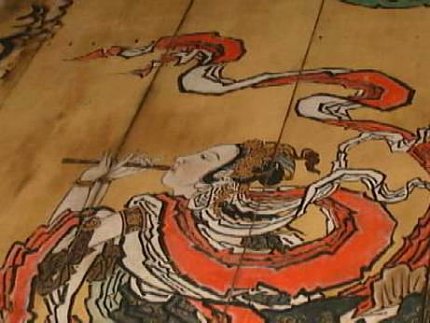
Tennyo Ceiling Painting, Myōshinji Temple 妙心寺 in Kyoto
Photo courtesy this Japanese site
Editor’s Note. Above site says this
ceiling painting is a Karyōbinga (see below)
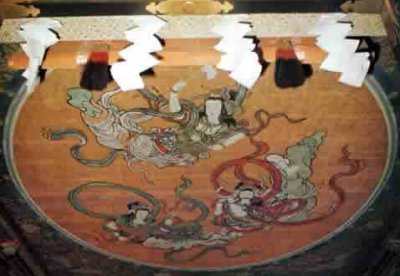
Tennyo Ceiling Painting
Photo courtesy this Japanese site
天女舞楽 = Tennyo Bugaku Dance
Celestial nymphs, dancing and playing musical instruments,
are painted on the ceiling at the Shinyosha (神興舎) Hall
at Tōshōgū Shrine 東照宮 (Tochigi Prefecture?).
Above painting by Ryōtaku Kano.
Bugaku 舞楽 dances and Gagaku 雅楽 music are an
amalgam of a wide variety of dances/music that were imported
into Japan from the Asian continent and incorporated into
official court functions. They are still performed today.
|
 |
|
  Karyōbinga 迦陵頻伽 (Karyobinga) Karyōbinga 迦陵頻伽 (Karyobinga)
Skt. = Kalavinka
Celestial beings who play music, dance, and fly through the air. They appear in many forms, often with bird’s body and angelic head, and are sometimes associated with Amida Nyorai. They appear often in Buddhist paintings, ritual robes, murals, and temple decorations.
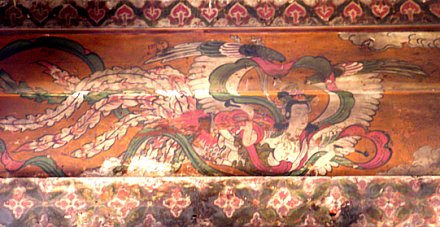
Karyōbinga Panel Painting, 1603 AD
Nakayamadera Temple 中山寺 (Hyogo Prefecture, 兵庫県)
Photo courtesy this Japanese site
Various Spellings for Karyōbinga:
- Karyōbinga, Karyobinga, Karyouibinga, Karyoobinga
- 迦陵頻伽
- 加隆頻迦
- 歌羅頻迦
- 加陵頻, 迦陵頻, 迦陵頻伽鳥,
迦蘭伽, 迦蘭頻伽, 迦毘伽,
迦毘頻伽, 迦毘伽, 迦毘伽羅,
迦尾羅, 羯羅尾羅, 羯毘伽羅
Karyoubinga
Postage Stamp
(issued 1972)
Photo courtesy
this J-Site |
|
 KARYOUBINGA. Below text courtesy JAANUS KARYOUBINGA. Below text courtesy JAANUS
Skt. = Kalavinka. Originally a sparrow-like bird that lived in the snowy mountains of the Himalaya range, reputed to possess a melodious voice. Later sutras state that it lived in the paradise (Gokuraku 極楽) of Amida 阿弥陀 Buddha. In pictorial representations, the karyōbinga has the head of a bodhisattva (bosatsu 菩薩) and the winged body of a bird. Its tail resembles the tail of a phoenix (hō-ō 鳳凰). Typically it holds a musical instrument. In Japanese art, the karyōbinga is found in a variety of forms:
- Cast in low-relief on pendant discs (keman 華鬘) used for architectural decoration (see below photo)
- Printed on priest's robes
- Painted on temple ceilings and wall panels
- Appears in paintings of Amida’s Pureland Paradise
(Jōdo Hensō 浄土変相)
Text Below Adapted from
Soothill’s Dictionary of Chinese Buddhist Terms
The Karyoubinga is a Himalayan bird with a melodious voice. It may be a sparrow, or it may be the kalandaka (kokila), the cuckoo. It "sings in the shell" before hatching. <end quote>
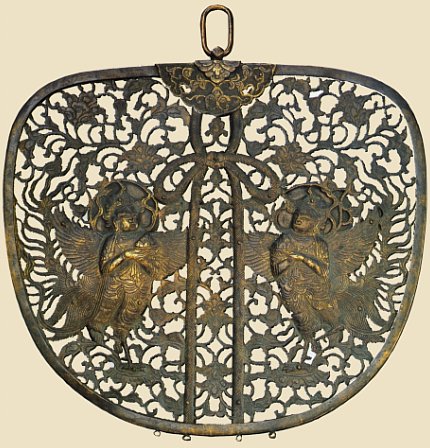
Two Karyoubinga on Stylized Garland (Keman 華鬘)
at Chūsonji Temple 中尊寺 (Iwate Pref.), Heian Era, 12th Century
Height 28.5 cm, Made of Gilt Bronze (金銅華鬘)
Photo courtesy 日本の美をめぐる, No. 35
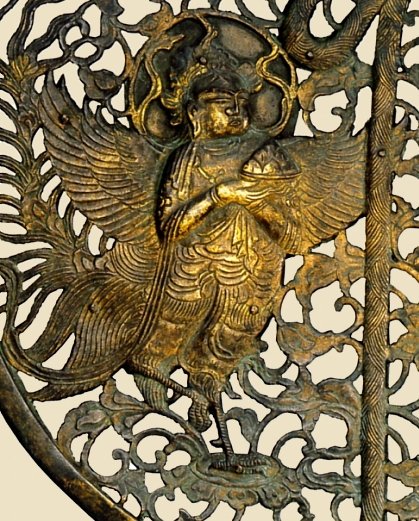
Karyoubinga, Closeup of Prior Keman Photo
Chūsonji Temple 中尊寺, Heian Era, 12th Century, H = 28.5 cm, Gilt Bronze
Photo courtesy 日本の美をめぐる, No. 35
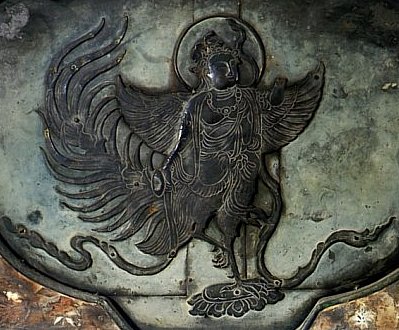
Karyoubinga Engraving on Octogonal Pedestal
Chūsonji Temple 中尊寺, 12th Century
(Length) 193.9 cm (Height) 52.5cm.jpg
Photo courtesy 日本の美をめぐる, No. 35
 |
Flower Garlands, Onaments, Keman
Below Text / Images Courtesy Tokyo Nat’l Museum
牛皮華鬘で、京都・東寺(教王護国寺)に伝来した。
Stylized garlands (Jp. = keman 華鬘), such as those shown below, are thought to have their origins in the fresh flowers that were offered to nobles in ancient India. They were later adopted by Buddhism and used as decoration (J. shōgon) that were hung on the crossbeams of temple halls. In Japan, ornaments made of leather, metal, wood, precious stone, silk, and other materials were used as substitutes for fresh floral garlands (J. kemanshiro). There are many examples of such objects in wide, round fan-shaped forms.
These stylized garlands, made of leather, originally belonged to Kyōgokoku-ji Temple, more commonly known as Tō-ji 東寺, in Kyoto. Today, thirteen ornaments remain, all of them fashioned in openwork leather, which were lacquered, primed with white clay, and then decorated with polychrome patterns. The thirteen can be roughly divided into two types based on their motifs. One type has two Kalavinkas (J. Karyōbinga, paradisiacal birds with human heads) facing each other on a ground of hosoge, imaginary Buddhist flowers, made to look like real flowers. The center shows a bow reminiscent of that which would have bound together fresh flowers. The Kalavinkas hold floral baskets containing blossoms to scatter on the buddhas and bodhisattvas in praise. In the other type, the bow is placed at the center with floral tendrils and arabesques (J. karakusa) covering the entire surface.
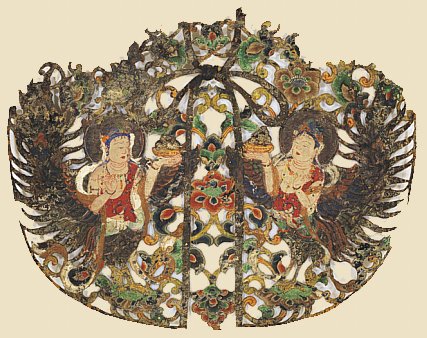
Keman fragment with two Karyōbinga
Click image for larger photo.
Heian Era, 11th Century, Nara National Museum, Made of Leather.
Photo courtesy Tokyo National Museum
牛皮華鬘で、京都・東寺(教王護国寺)に伝来した
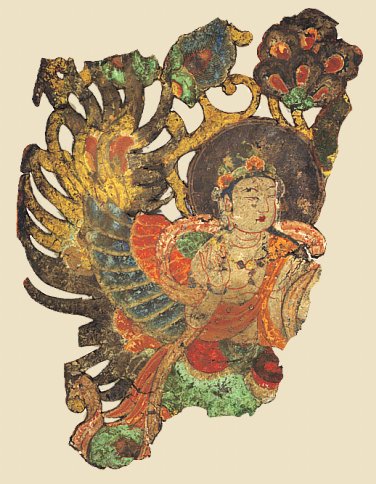
Keman fragment with Karyōbinga.
Heian Era, 11th Century, Nara National Museum, Made of Leather.
Photo courtesy Tokyo National Museum
牛皮華鬘で、京都・東寺(教王護国寺)に伝来した
The thirteen pieces exhibit individual differences in style. Since there are at least three or four distinguishable styles in both garland types, it is difficult to believe that these ornaments originally formed one set. The superior stylistic treatment exhibited in Stylized Garlands numbers 7 and 8, seen in the use of the red lines on the bodies of the Kalavinka and the delicate cut gold leaf on the robes, reflects traditional techniques of Buddhist painting of the Heian period (794-1185). On the ornaments with only floral tendrils and arabesques, a gradation technique called ungen zaishiki 繧繝彩色 (in which several shades of similar hue are closely brushed together) and delicate patterns of cut gold leaf were applied.
The iconography of two Kalavinkas facing each other on a ground of floral tendrils can also be found on the gilt-bronze openwork garlands of Chūson-ji Temple in Iwate Prefecture, which are presumed to date from the first half of the twelfth century. The resplendent examples in the Nara National Museum are thought to have preceded the Chuuson-ji pieces. Although there is no record as to the hall in which the former garlands were used, they are believed to have been produced sometime in the 11th century. <end quote Tokyo National Museum>
 |
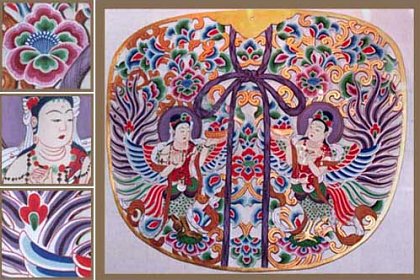
Karyōbinga -- Modern Keman
by artist Inaki Nobuyuki (稲木 伸行)

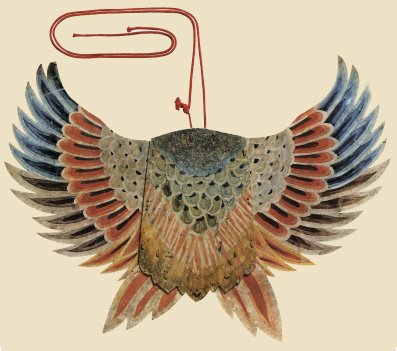
Wings of Karyōbinga Dance, Kamakura Era, 13th Century
Hide with Pigments, W = 63.5 cm, Hōryuuji Temple 法隆寺 (Nara)
. Photo courtesy of 1994 Exhibition Catalog entitled
Treasures of Hōryūji Temple, Tokyo National Museum
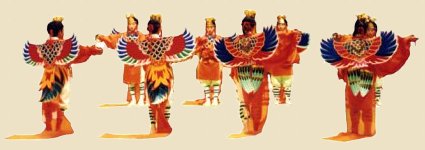
Bugaku Dance, Karyōbinga’s Wing Costume
Artwork courtesy this Japanese site
Half Human and Half Bird 半人半鳥
|

OTHER HEAVENLY MUSICIANS
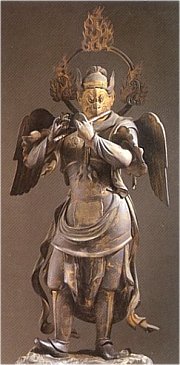
Karura 迦楼羅
The Karyoubinga is sometimes associated with Karura
(Skt. Garuda, Garudas), the Hindu bird-man deity and
mount of the Hindu god Vishnu (Visnu).
See Karura page for more details about this deity.

OTHER HEAVENLY MUSICIANS
|
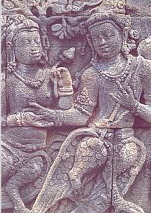
In Indonesian, Kinnara
is half-man, half-bird.
Stone, 900 AD
Borobudur, Java
Photo courtesy of
www.kinnara.or.id
Kinnara
Playing the drum
Sanjusangendo (Kyoto) |
|
 KINNARA 緊那羅 Skt. = Kimnara KINNARA 緊那羅 Skt. = Kimnara
Celestial musicians, depicted in Hindu mythology with human bodies and horses' heads, officiating at the court of the Hindu deity Kuvera (Kubera; known as Tamonten in Japan), a god of wealth. In Southeast Asia, they are also represented in the shape of a bird with human head holding a musical instrument and are reputed to have marvelous voices. This iconography is very similar to the half-bird-half-man Karyoubinga (this page). In China, Buddhist monks claim that the Taoist deity of the Kitchen, Zao Jun, is in fact a Kinnara. In Hindu legends, the Kinnaras are birds of paradise and typically represented as birds with human heads playing musical instruments.
KENDATSUBA / KANDABBA 乾闥婆
Skt. = Gandharvas
Below text courtesy JAANUS
The Gandharvas are musicians in the paradise of the Hindu god Indra (Jp. Taishakuten), and are well known in the Vedic pantheon. In Japan they are seldom represented. Says JAANUS: Kendatsuba is a transliteration of the Sanskrit Gandharva, translated as Jikikou 食香 (scent-eater ), Jinkou 尋香 (scent-seeker), and also known as Koujin 香神 (scent god). A class of semi-divine beings that feed on the fragrance of herbs. In later Indian mythology they are regarded as celestial musicians, in which role they were incorporated into Buddhism as attendants of Taishakuten 帝釈天 (Indra), who is a protector of Buddhist law. They are also counted among the attendants of Jikokuten 持国天, the guardian king of the eastern direction. They are among the eight classes of beings that protect Buddhism (Hachibushuu 八部衆), and among the twenty-eight classes of beings (Nijuuhachibushuu 二十八部衆) that serve as attendants to Senju Kannon 千手観音, and among the 33 manifestations of Kannon 観音 mentioned in the Lotus Sutra. They are also regarded as guardians of children, and it is in this role that one of their kings, called Sendan Kendatsubaou 栴檀乾闥婆王, figures at the center of the Doujikyou Mandala 童子経曼荼羅, which is used in Esoteric Buddhist rituals to ward off danger and illness from children. <end JAANUS quote>
Says Soothill in his Dictionary of Chinese Buddhist Terms: “Spirits on Gandha-mādana 香 山, the fragrant or incense mountains, so called because the Gandharvas do not drink wine or eat meat, but feed on incense or fragrance and give off fragrant odours. As musicians of Indra, or in the retinue of Dhrtarastra  they are said to be the same as, or similar to, the Kinnaras. The Dhrtarastra are associated with soma, the moon, and with medicine. They cause ecstasy, are erotic, and the patrons of marriageable girls; the Apsaras are their wives, and both are patrons of dicers.” <end Soothill quote> they are said to be the same as, or similar to, the Kinnaras. The Dhrtarastra are associated with soma, the moon, and with medicine. They cause ecstasy, are erotic, and the patrons of marriageable girls; the Apsaras are their wives, and both are patrons of dicers.” <end Soothill quote>
There are many kinds of transcriptions of Gandharva. Soothill mentions the following: 乾闥婆, 乾沓婆, 乾沓和, 健達婆, 健闥婆, 健達縛, 健陀羅, 彦達縛.

LEARN MORE
- Tenbu (Deva) Main Menu. This site. Lists nearly 80 deities.
- Bosatsu on Clouds Byoudou-in Temple, Japan. This Site.
View the beautiful sculptures of Flying Apsaras at Byoudou-in.
- Dunhuang Caves in China ( 敦煌 Jp. Tonko). This Site.
Various photos and stories on the Apsaras at Dunhuang.
Data on the Mo-kao (Mogao) Caves & the Apsaras of Music.
- Apsaras at Dunhuang (China). Please see Gabi Greve’s page for many more photos of the Apsaras paintings found in the caves of Dunhuang, China. Outside link.
- Apsaras appear often in the stone carvings at the Angkor Watt ruins in Cambodia. Visit this outside link for a few photos.
- At Kakuonji Temple in Kamakura, a large statue of Yakushi Nyorai is flanked by two bosatsu, Nikko (sun) and Gakko (moon). The latter two statues are adorned with Karyoubinga images. These statues were carved in 1422 AD by a local sculptor named Choyu. Highly recommended for those interested in Buddhist sculputure. Tours given daily. No photos allowed.
- For much more on KEMAN 華鬘, please see Gabi Greve's page on Flower Garlands. Outside link.
- Definition of Apsaras from Wikipedia. Apsaras, in Hindu and Buddhist mythology, are the celestial damsels of Indra's court, created by Lord Brahma. Natya Shatra lists the following Apsaras: Manjukesi, Sukesi, Misrakesi, Sulochana, Saudamini, Devadatta, Devasena, Manorama, Sudati, Sundari, Vigagdha, Vividha, Budha, Sumala, Santati, Sunanda, Sumukhi, Magadhi, Arjuni, Sarala, Kerala, Dhrti, Nanda, Supuskala, Supuspamala and Kalabha. <source = Wikipedia>
- Buddhism: Flammarion Iconographic Guides by Louis Frederic, Printed in France. ISBN 2-08013-558-9, First published 1995. A highly illustrated volume, with special significance to those studying Japanese Buddhist iconography. Includes many of the myths and legends of mainland Asia as well, but its special strength is in its coverage of the Japanese tradition. Hundreds of accompanying images/photos, both B&W and color. A useful addition to your research bookshelf.
- Apsaras in Sanskrit means “essence of the waters.” It can also mean “moving in or between the waters.” The Apsaras are divine beauties, dancers of the gods, said to dwell in Svarga, the paradise of Lord Indra.

|
|